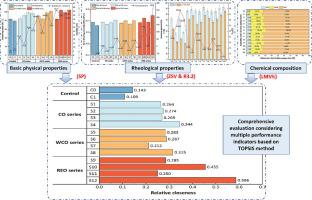Construction and Building Materials ( IF 7.4 ) Pub Date : 2023-02-20 , DOI: 10.1016/j.conbuildmat.2023.130724
Jinxi Zhang , Duowang Yang , Guoqiang Sun , Yiwen Li , Yue Qi , Xiaoyan Ma

|
Using recycled oils and chemical stabilizers as the additives in high-viscosity modified asphalt (HVMA) is being developed as a sustainable way to solve the severe segregation problems due to the large differences in nature between high-content styrene–butadienestyrene (SBS) and base asphalt. This paper attempts to use three recycled oils, namely castor oil (CO), waste cooking oil (WCO) and recycled engine oil (REO), as compatibilizers in combination with different chemical stabilizers (polyphosphoric acid, PPA; sulfur) to investigate their ameliorative roles on HVMA segregation problems. By means of the gel permeation chromatography, dynamic shear rheometer and fluorescence microscopy, the chemo-rheological properties and morphological structures of HVMA are investigated, as well as their storage stability. Results show that the recycled oils are more favorable to improve the high-temperature rheological performance of HVMA than aromatic oil (AO) by comprehensively considering the softening point, zero-shear viscosity, elastic recovery percent and large molecule percentage, and the role ranking is: REO > WCO > CO > AO. Compared with the addition of PPA or sulfur alone, when PPA and sulfur are added together, the rheological performance of HVMA is promoted most significantly, because of the synergistic cross-linking reaction of these chemical stabilizers with asphalt and polymers. Furthermore, the synergistic effect of PPA and sulfur markedly reduces the temperature sensitivity of HVMA. However, the cigar tube test reflects that adding recycled oils as compatibilizers alone can not improve the storage stability of HVMA, and CO and WCO even aggravate its segregation. Notably, adding REO and chemical stabilizers can markedly improve the storage stability of HVMA, and the effect is most obvious when REO, PPA and sulfur are added together.
中文翻译:

再生油、多聚磷酸和硫磺对高粘度改性沥青化学流变学和形态学特性的影响
使用回收油和化学稳定剂作为高粘度改性沥青 (HVMA) 中的添加剂正在开发,作为解决由于高含量苯乙烯-丁二烯苯乙烯 (SBS) 与基苯乙烯 (SBS) 之间的巨大性质差异而导致的严重离析问题的可持续方法沥青。本文尝试使用三种再生油,即蓖麻油(CO)、废食用油(WCO)和再生机油(REO)作为相容剂,结合不同的化学稳定剂(多聚磷酸,PPA;硫磺)来研究它们的改善效果HVMA 隔离问题上的作用。通过凝胶渗透色谱、动态剪切流变仪和荧光显微镜,研究了 HVMA 的化学流变学性质和形态结构,以及它们的储存稳定性。结果表明,综合考虑软化点、零剪切粘度、弹性恢复百分比和大分子百分比,再生油比芳烃油(AO)更有利于提高HVMA的高温流变性能,作用排序为: REO > WCO > CO > AO。与单独添加PPA或硫磺相比,当PPA和硫磺一起添加时,HVMA的流变性能提升最为显着,因为这些化学稳定剂与沥青和聚合物发生了协同交联反应。此外,PPA 和硫的协同作用显着降低了 HVMA 的温度敏感性。然而,雪茄管试验反映单独添加再生油作为相容剂并不能提高HVMA的储存稳定性,而CO和WCO甚至加剧了它的隔离。值得注意的是,添加REO和化学稳定剂可以显着提高HVMA的储存稳定性,其中当REO、PPA和硫一起添加时效果最为明显。

































 京公网安备 11010802027423号
京公网安备 11010802027423号